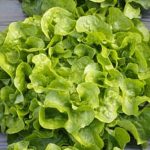Are you a vegetable gardener looking for a comprehensive guide to help you grow the best produce possible? Look no further than The Vegetable Gardener’s Bible. This indispensable resource provides everything you need to know about cultivating a successful and bountiful vegetable garden. From planning and planting to harvesting and preserving, this book covers it all.
The Vegetable Gardener’s Bible is much more than just a beginner’s guide-it’s an essential tool for both novice and experienced gardeners alike. This article will provide you with an overview of what this bible has to offer, including tips on planning your garden, selecting the right vegetables, soil preparation, pest control, seasonal care, harvesting, and even success stories from other vegetable gardeners.
No matter where you are in your gardening journey, this book will provide invaluable guidance to help you achieve your gardening goals.
In the following sections, we will delve into the various aspects of vegetable gardening covered in The Vegetable Gardener’s Bible. From choosing the right location for your garden and essential tools and equipment needed for success to advice on soil preparation and maintenance, as well as pest control and seasonal care-this article will equip you with the knowledge needed to create and maintain a thriving vegetable garden.
With expert guidance and tips from successful vegetable gardeners included in the bonus section, this bible truly has something for everyone who wants to grow their own produce.
How to Plan Your Vegetable Garden
Planning your vegetable garden is an essential step in ensuring a successful and bountiful harvest. Here are some tips to help you get started:
- Choose the right location: When planning your vegetable garden, it’s important to select a location that receives at least 6-8 hours of sunlight per day. Additionally, consider factors such as water access and proximity to your home for convenience.
- Design and layout: Maximizing space and productivity is key to a successful vegetable garden. Consider using raised beds or container gardening to make the most of limited space. Additionally, companion planting can help deter pests and maximize yield.
- Consider crop rotation: To maintain soil fertility and reduce the risk of disease, plan for crop rotation in your garden layout. This means systematically changing the placement of different vegetable families each year.
Proper planning will set the stage for a thriving vegetable garden that will provide you with fresh produce throughout the growing season. The Vegetable Gardener’s Bible provides detailed guidance on these essential steps, ensuring that both beginner and experienced gardeners have all the information they need to plan their perfect vegetable garden.
Whether you’re starting your first vegetable garden or looking to expand your existing one, having a comprehensive guide like The Vegetable Gardener’s Bible can make all the difference in achieving gardening success. From choosing the right location and design layout to proper soil preparation and maintenance, this valuable resource is a must-have for every vegetable gardener.
Essential Tools and Equipment for Vegetable Gardening
When it comes to vegetable gardening, having the right tools and equipment can make all the difference in the success of your garden. The Vegetable Gardener’s Bible emphasizes the importance of using the proper tools for maintaining a healthy and productive garden. Here are some essential tools that every vegetable gardener should have:
- Spade or shovel: A spade or shovel is essential for breaking up soil, digging holes for planting, and moving compost or other materials around the garden.
- Hand trowel: This smaller tool is perfect for transplanting seedlings, digging small holes for planting, and weeding in tight spaces.
- Garden fork: A garden fork is ideal for turning over soil, lifting plants, and aerating the ground to promote healthy root growth.
- Pruning shears: These are necessary for cutting back plants, harvesting fruits and vegetables, and removing dead or diseased foliage from your garden.
The Vegetable Gardener’s Bible also highlights the significance of having quality equipment such as hoses, watering cans, gloves, and wheelbarrows to ensure that your gardening tasks are completed efficiently. By investing in these essential tools and equipment, you can set yourself up for a successful gardening experience.
In addition to basic tools, there are also specialized equipment that can aid in maintaining a healthy garden. These could include items such as a moisture meter to monitor soil moisture levels, a pH meter to test soil acidity or alkalinity, and a hand-held cultivator for loosening compacted soil.
Having these additional tools at your disposal can provide valuable insight into the condition of your garden soil and help you make informed decisions about its maintenance. The Vegetable Gardener’s Bible recommends acquiring these specialized tools to maximize the productivity of your vegetable garden.
Selecting the Right Vegetables for Your Garden
When it comes to vegetable gardening, one of the most crucial decisions a gardener makes is selecting the right vegetables to grow. This step can be overwhelming, especially for beginners, but with the help of The Vegetable Gardener’s Bible, you can make informed choices that will ensure a successful harvest.
Factors to Consider
There are several factors to consider when choosing which vegetables to grow in your garden. These factors include your location and climate, the amount of sunlight your garden receives, as well as your soil quality. The Vegetable Gardener’s Bible provides valuable information on how these factors can affect the growth and productivity of different vegetables.
Beginner-Friendly Vegetables
For first-time gardeners, it’s important to start with vegetables that are relatively easy to grow and maintain. The Vegetable Gardener’s Bible recommends beginner-friendly vegetables such as tomatoes, lettuce, carrots, and radishes. These vegetables are not only easier to grow but also have a high success rate for first-time gardeners.
With the guidance found in The Vegetable Gardener’s Bible, you can confidently choose the right vegetables for your garden based on your specific needs and circumstances. Whether you have limited space or varying weather conditions, this comprehensive guide will provide you with valuable insights on making the best choices for a successful harvest.
Soil Preparation and Maintenance
One of the most crucial aspects of successful vegetable gardening is proper soil preparation and maintenance. The Vegetable Gardener’s Bible emphasizes the importance of starting with healthy, nutrient-rich soil to ensure a bountiful harvest. In this section, we will delve into the guide’s recommendations for testing and improving soil quality, as well as tips for composting and using natural fertilizers.
Testing your soil is the first step in understanding its composition and identifying any deficiencies that need to be addressed. The Vegetable Gardener’s Bible provides detailed instructions on how to conduct a soil test, either through DIY kits or professional laboratory analysis. By knowing the pH level, nutrient content, and texture of your soil, you can make informed decisions about what amendments are needed to optimize its fertility.
Composting is another fundamental practice advocated by The Vegetable Gardener’s Bible. The guide offers valuable insights into creating your own compost pile, including the best materials to use and the process of decomposition. Additionally, it introduces various natural fertilizers such as manure, bone meal, and seaweed extract, detailing their benefits and application methods in sustaining a healthy garden ecosystem.
| Soil Preparation | Soil Maintenance |
|---|---|
| Importance of testing soil quality | Tips on composting |
| Methods for improving soil fertility | Use of natural fertilizers |
Pest and Disease Control
When it comes to maintaining a healthy and thriving vegetable garden, pest and disease control is an essential aspect of gardening that every vegetable gardener should be familiar with. The Vegetable Gardener’s Bible provides valuable information and guidance on how to effectively deal with common pests and diseases that can affect your garden.
One of the most important things to understand as a vegetable gardener is the different types of pests and diseases that can potentially harm your plants. The Vegetable Gardener’s Bible emphasizes the importance of being able to identify these pests and diseases early on in order to prevent them from causing serious damage to your garden.
By being able to recognize the signs and symptoms of common issues such as aphids, caterpillars, blight, or powdery mildew, you can take proactive measures to address these problems promptly.
In addition, The Vegetable Gardener’s Bible also provides a comprehensive overview of organic and chemical-free methods for controlling pests and diseases in your garden. From introducing beneficial insects as natural predators to using homemade remedies such as garlic spray or neem oil, this guide offers a variety of effective strategies for combating common garden threats without relying on harsh chemicals. As a result, you can maintain the health of your vegetables while minimizing potential harm to the environment.
Overall, having a solid understanding of pest and disease control is crucial for any vegetable gardener looking to cultivate a successful garden. With its valuable insights and practical advice, The Vegetable Gardener’s Bible serves as an indispensable resource for learning how to identify, prevent, and address these common challenges, ultimately helping you achieve a bountiful harvest year after year.
Seasonal Care and Maintenance
Caring for your vegetable garden throughout the changing seasons is vital to its success. The Vegetable Gardener’s Bible provides a comprehensive guide to help you navigate through the different tasks needed to maintain a healthy and productive garden all year round.
In the spring, it’s essential to prepare your garden for planting. This includes clearing away any debris from the winter months, testing the soil, and amending it as necessary. The Vegetable Gardener’s Bible recommends starting seeds indoors for certain vegetables and then transplanting them outdoors once the danger of frost has passed. It also provides guidance on protecting young plants from late cold snaps and heavy rains.
As summer approaches, the focus shifts to watering, weeding, and monitoring plant health. The book offers tips on proper watering techniques and mulching to conserve moisture in the soil. It also advises vigilance in keeping an eye out for pests and diseases that tend to thrive in warmer temperatures. Additionally, The Vegetable Gardener’s Bible suggests succession planting to ensure a continuous harvest throughout the season.
In fall, preparation for winter and planning for the next growing season become priorities. The book outlines tasks such as harvesting remaining crops, preparing the soil for winter with cover crops or mulch, and cleaning and storing gardening tools. It also offers advice on crop rotation strategies and selecting cold-hardy vegetables to extend the harvest well into autumn. Following these recommendations can help ensure a bountiful harvest from your vegetable garden year after year.
| Vegetable Garden Seasonal Care | Tasks |
|---|---|
| Spring | Prepare garden for planting Clear debris Test soil Amend soil Start seeds indoors Transplant seedlings Protect plants from late frost/rain |
| Summer | Watering Weeding Monitoring plant health Mulching Pest/Disease control Succession planting |
| Fall | Harvest remaining crops Prepare soil for winter Cleaning/storing tools Crop rotation Cold-hardy vegetables selection |
Harvesting and Preserving Your Vegetables
Best Practices for Harvesting
When it comes to harvesting your vegetables, timing is key. The Vegetable Gardener’s Bible emphasizes the importance of harvesting at the right time to ensure that you get the best flavor and quality from your produce.
Different vegetables have different indicators for harvest, so it’s important to familiarize yourself with the specific signs to look for. For example, with tomatoes, they should be fully colored and firm to the touch before picking, while root vegetables like carrots should be harvested when they have reached their full size.
Techniques for Preserving Your Harvest
Preserving your harvest allows you to enjoy the fruits of your labor long after the growing season has ended. The Vegetable Gardener’s Bible provides valuable information on various preservation techniques such as canning, freezing, and drying. Each method has its own set of advantages and is suitable for different types of vegetables. For instance, high-acid foods like tomatoes are ideal for canning, while leafy greens and herbs can be dried for long-term storage.
Tips for Long-Term Storage
In addition to preserving your harvest through various techniques, proper storage is essential in ensuring that your vegetables remain fresh for as long as possible. The Vegetable Gardener’s Bible offers tips on storing different types of vegetables, including recommended temperature and humidity levels.
For example, root vegetables such as potatoes and onions should be stored in a cool, dark place with good ventilation to prevent sprouting and spoilage. By following these storage guidelines, you can enjoy homegrown produce throughout the year.
Bonus
In conclusion, The Vegetable Gardener’s Bible serves as an indispensable resource for both beginner and experienced gardeners. With comprehensive guidance on everything from planning and maintenance to pest control and preserving your harvest, this book truly lives up to its title as a “bible” for vegetable gardening enthusiasts. By providing essential information and practical tips, it empowers individuals to create thriving gardens that yield an abundance of fresh produce.
One of the most valuable features of The Vegetable Gardener’s Bible is the inclusion of success stories from other vegetable gardeners. These real-life examples not only inspire readers but also provide valuable insights and tips based on the experiences of those who have used the book to achieve their gardening goals. It serves as a reminder that with dedication, knowledge, and the right tools, anyone can become a successful vegetable gardener.
In essence, The Vegetable Gardener’s Bible is not just a manual for growing vegetables-it is a source of inspiration and motivation for individuals looking to cultivate their own bountiful gardens. Aspiring gardeners can take comfort in knowing that they are not alone in their journey, and with the guidance provided in this comprehensive guide, they too can experience the joy of growing their own fresh produce right in their backyard.
With its wealth of information and firsthand accounts of success, this book truly has the power to transform any aspiring gardener into a confident and skilled vegetable-growing enthusiast.

If you’re looking to get into vegetable gardening, or are just looking for some tips on how to make your current garden better, then you’ve come to the right place! My name is Ethel and I have been gardening for years. In this blog, I’m going to share with you some of my best tips on how to create a successful vegetable garden.





